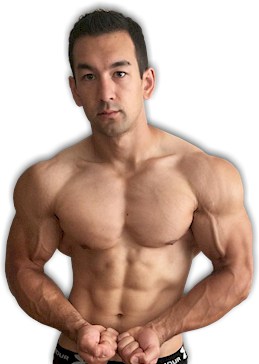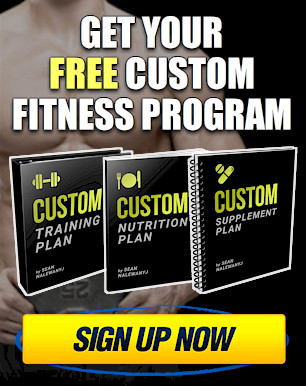BODYBUILDING AND FAT LOSS Q&A WITH SEAN NALEWANYJ: PART 6
Welcome back to my Bodybuilding And Fat Loss Q&A series where I’ll be covering 5 more commonly asked questions with straight to the point, no B.S answers that you can take and apply to your program.
We’re now onto part 6, and if you want to go back and access the previous Q&A’s we’ve done so far, just use the links below…
– Part 1
– Part 2
– Part 3
– Part 4
– Part 5
Okay, let’s begin…
Q: What is the ideal time to perform cardio in order to maximize fat loss?
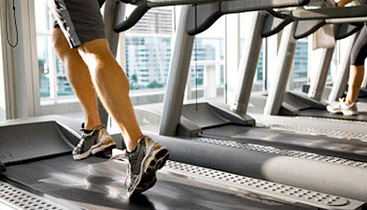
You’ll generally hear two main recommendations on this one…
The first is to perform cardio first thing in the morning on an empty stomach, since it will force the body to burn a higher percentage of fat as opposed to carbohydrates during the session.
However, as I touched on in part 1 of this series, fasted cardio does not actually increase fat loss in any measurable way in comparison to fed cardio, and it may actually be counterproductive by lowering overall training performance and increasing muscle loss.
The second is to perform cardio immediately post workout. The reason for this is that since glycogen levels will be depleted from the weight training session, the body will again have no choice but to tap into its fat stores for fuel.
This one is also misguided though, since even an exhaustive weight training workout will only lower glycogen stores by around 30-40%, leaving plenty in the tank for post workout cardio.
Rather than trying to time out your cardio in some special way to somehow improve its burning effects, just schedule it at whatever time of day fits best into your schedule and whenever you feel the most motivated to train at your best.
Assuming your goal is to build/maintain muscle and gain strength at your maximum potential though, the one piece of advice I would give here is to avoid performing cardio immediately pre-workout.
Weight training should always be treated as the top priority in your plan, and you definitely don’t want to be entering your workout already physically and mentally pre-fatigued from a full cardio session.
This is especially true if the cardio method heavily involves muscles that you’ll be training during the workout, such as using a stairclimber before a leg workout or a rowing machine before a back workout.
Q: Are wide-grip dips a good addition to a chest training routine?
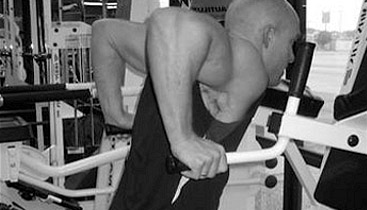
Although I did used to perform these as part of my chest workouts many years ago, I no longer include wide-grip dips in my own personal routines or in the routines that I design for my training clients for the simple reason that I don’t feel the risk/reward ratio justifies it.
Dips do allow you to train your chest with a reasonable degree of effectiveness, but given that they place the shoulder joints into a risky position and that there are superior exercises available for maximizing pec stimulation anyway, it just doesn’t make sense to bother with them in my opinion.
Dips do involve a certain degree of horizontal adduction (this is the primary function of the pecs), but the movement itself is still mostly a combination of shoulder flexion and elbow extension. For that reason, it’s actually your front delts and triceps that perform the bulk of the work here.
On top of this, the wide-grip dip promotes both internal rotation of the humerus and scapular protraction, which puts the shoulder joint into a more vulnerable position that increases the chances for injury.
I’m certainly not saying that dips don’t work for building up the chest or that you’re guaranteed to get hurt by performing them, but if your goal is to hit your pecs as effectively as possible while minimizing the stress on your shoulder joints, there are just simply better options available, such as dumbbell presses and cable fly movements.
If you really enjoy performing wide-grip dips and want to continue doing so then that’s up to you, but at the very least I’d recommend placing them as a lower priority movement in your chest routine, sticking to lighter weight/higher reps, and performing the movement under very strict control at all times.
Q: Is eating late at night counterproductive for fat loss?
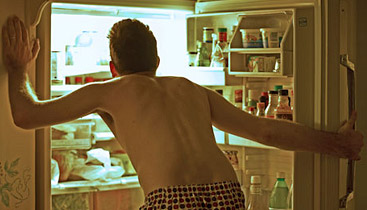
Assuming that your overall calorie intake and activity level remains constant, consuming a larger percentage of your total food intake earlier or later in the day won’t make any real difference when it comes to bottom line fat loss.
The logic that most people use here is that since activity level and metabolic rate decrease in the late night hours, calories consumed during this period will be more likely to be stored as fat. And while that may be true, it still makes no difference if you have a consistent, ongoing calorie deficit in place from day to day.
As I mentioned before, fat loss is not an “on/off” switch. Rather, fat storage and fat burning are happening continuously throughout the entire day, and it’s the sum total of all the fat storing processes minus the fat burning processes that determines your bottom line results.
If person A consumes a greater amount of their total calories in the evening while person B consumes a greater amount early in the day, but both are maintaining a net 500 calorie deficit, they’re actually in the same boat as far as total fat loss is concerned…
– A greater amount of person A’s calories will be immediately stored as fat (since there is less of an energy demand at that time), but will be broken down and utilized later on when the energy demand is higher.
– A smaller amount of person B’s calories will be immediately stored as fat (since there is a greater energy demand at that time), but more will be stored later on once the energy demand runs out.
So, if you’ve been intentionally starving yourself in the evening and going to bed hungry even though you’d prefer to eat something, you can stop worrying.
Just figure out what your total calorie needs are for fat loss throughout the day as a whole, and then if you want to allocate some of those calories to the later night hours, that’s completely fine.
Q: Which form of cardio is most effective for burning fat: LISS (low intensity steady state) or HIIT (high intensity interval training)?
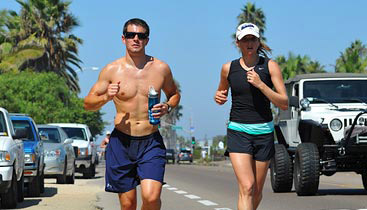
In a direct head-to-head comparison, it does appear that performing cardio at a higher level of intensity over a shorter duration of time is in fact superior for overall fat loss in comparison to lower intensity, longer duration sessions.
This is because HIIT cardio not only burns a significant number of calories during the actual workout itself, but also produces an increase in EPOC (excess post exercise oxygen consumption) which causes your body to expend energy for several hours even after the session is over.
Low intensity cardio does burn a greater percentage of fat during the workout, but high intensity cardio still burns a greater net amount of fat over a 24 hour period.
However, that increase in fat loss does come at a price since HIIT cardio is a lot more demanding on your body as a whole. If you’re already performing several weight training workouts per week, there’s only so much HIIT cardio you can add on top of that before the overall weekly workload becomes too great.
This is where low intensity cardio becomes beneficial, since it still allows you to burn a reasonable number of calories but without taxing your body to a significant degree.
So, even though HIIT cardio is superior for fat loss on a workout-for-workout basis in comparison to LISS cardio, your training plan will likely still contain a mixture of both in order to properly manage overall recovery.
Q: Is protein powder a necessary supplement for gaining muscle?
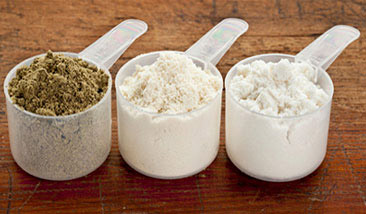
At the end of the day, the decision to either use or not use a protein powder as part of your muscle building or fat burning plan really just comes down to an issue of convenience.
Since protein powders allow you to consume an easy 20-30 grams of protein through one relatively small scoop and in liquid form if you prefer, it can be a very useful way to streamline your diet and hit your daily protein needs with more ease.
However, there’s nothing “magical” about protein powder and you’ll still be able to build muscle and lose fat just as effectively with or without it as long as you’re consuming an adequate amount of total daily protein from other high quality sources.
Most people think of whey protein as being some sort of “high-tech” muscle building supplement that will somehow “super-charge” their muscle building results, but it’s really just not the case.
Although most protein powders will provide you with a very high quality form of protein, it still won’t make any measurable difference within the context of a complete diet that provides around 1 gram of protein per pound of body weight daily and is based around other good whole food sources like chicken, red meat, fish etc.
This is because ALL forms of protein are ultimately broken down into their individual amino acid building blocks, and your body can only use a finite amount each day in order to max out its muscle building capabilities over that time period.
So, with or without a protein powder, you’ll still end up getting all the essential amino acids you need to optimize muscle growth as long as you’re hitting your total protein needs for the day from other high quality sources.
All that said, consuming 1 or 2 protein shakes per day usually does improve the convenience and consistency of most people’s diet plans, and so a high quality protein powder is still something that most trainees will benefit from.
However, just don’t make the mistake of thinking it’s somehow mandatory, and if you’d prefer to consume solid foods only, that’s completely fine as well.
I hope this Q&A provided some useful information that you can apply to your program. Thanks for reading, and Part 7 will be coming your way very soon.
If you found this article helpful, make sure to sign up for your FREE custom fitness plan below...



